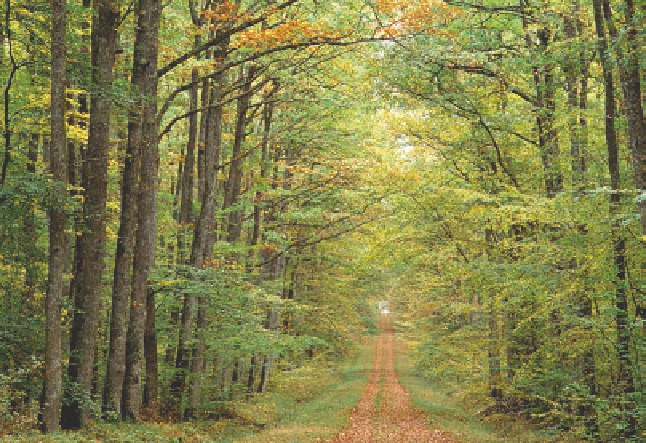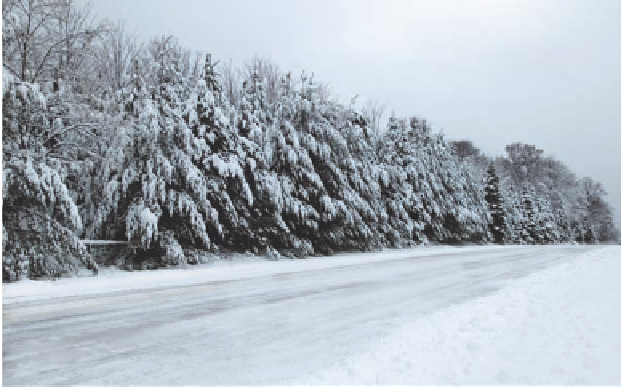Geoscience Reference
In-Depth Information
perature range can be seen in the vegetation, which is domi-
nated by boreal forests consisting of needle-leaf trees such as
pine, spruce, and fir (Figure 9.12). The
Dwc
variant is found
only in far eastern Russia and is characterized by a distinct win-
ter drought. The
Dwd
variant occurs only in extreme northeast-
ern Siberia and is distinctive because, in addition to a winter
drought, its coldest month is below -38°C (-36.4°F).
The subarctic climates (
Dfc
,
Dwc
,
Dwd
) are the source re-
gions of cold, dry cP air masses and are often invaded by more
frigid cA air masses that originate at still higher latitudes. Given
that this region is often north of the midlatitude storm track,
the annual amount of precipitation is relatively low. Most pre-
cipitation occurs during the summer months, when the belt of
cyclonic storms migrates into the region from the south. Oth-
erwise, the polar high-pressure system dominates the region,
resulting in little rainfall. The annual range of temperature is
greater within this climate than any other. (
Do you remember
why this extreme range occurs? Think back to previous discus-
sions about Earth-Sun geometry, seasonality, and insolation
.)
Figure 9.10 The humid continental hot-summer climates
(
Dfa, Dwa
).
Deciduous forest in the humid continental hot-sum-
mer climate, including various oak and maple species, covered
much of this climate region in the United States prior to European
settlement.
Polar (
E
) Climates
The most extreme climates in nonmountainous areas are the po-
lar
E
climates, which occur at latitudes higher than 70° N and S
latitude. The tundra climate (
ET
) is one of the two polar climate
subcategories and is found along the arctic coastal fringes, in-
cluding such places as the island region of northern Canada, the
north slope of Alaska, the Hudson Bay region, coastal Greenland,
and all of northern Eurasia (Figure 9.2). Given this geographi-
cal location, a moderating climate effect occurs from the nearby
oceans, resulting in winter temperatures less severe than in the
more continental regions to the south. Nevertheless, winters are
very long and cold and summers are short and cool. In north-
ern Alaska, for example, the average high in January is
-
11°C
(13°F) and an average high in July is 15°C (59°F). Very little
Subarctic Climates
The third major subdivision of the
D
climates is the subarctic climates (
Dfc
,
Dwc
,
Dwd
). These cli-
mate zones occur poleward of the humid continental climates
(
Dfa
,
Dwa
,
Dfb
,
Dwb
), stretching across all of northern North
America and from northern Scandinavia east across all of Asia
(Figure 9.2). It is a continental climate characterized by long,
bitterly cold winters and short, cool summers. In northwestern
Canada, where the
Dfc
subdivision occurs, the average high
January temperature is about -25°C (-13°F), whereas it ap-
proaches 20°C (69°F) in July. The impact of this extreme tem-
Figure 9.11 The humid continental mild-summer climates
(
Dfb
,
Dwb
).
Pine forest in northern Michigan. This type of veg-
etation is closely associated with the wet-winter variant (
Dfb
) of
this climate.
Figure 9.12 The subarctic climate (
Dfc
).
Typical vegetation in
the subarctic climate (
Dfc
) consists of needle-leaf trees and scat-
tered openings of birch and aspen.





